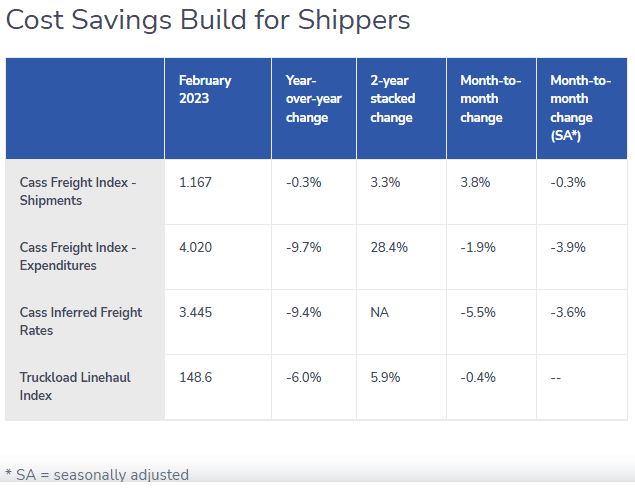The Cass Freight Report for February was released Tuesday, and it showed trucking volumes were basically flat versus January and year-over-year, as the data as with previous months showing mixed indicators of the “state of the freight.”
Surpply Chain Digest Says...
|
 |
Looking at the US freight market as a whole, Denoyer says that “At the risk of stating the obvious, the fundamental reason truckload spot rates are still falling is there are too many drivers chasing too little freight.”
|
 |
What do you say? |
| Click here to send us your comments |
 |
| |
|
The monthly report from Cass and partner Tim Denoyer of ACT Research is based on data from the billions of dollars of freight bills that Cass pays for its shipper clients.
The Cass shipments index, which covers several modes but is weighed towards full truckload rates, was mostly flat in February month-over-month, dropping 0.3% on a seasonally adjusted basis. It was also down 0.35 versus February 2022.
The shipments index rose in January versus last year, but Cass says that was against an easy comparison, with volumes in 2022 reduced due to the impact of the omnicon version of COVID.
It’s worth noting that the shipment index has been close to flat from October through last month.
“Soft real retail sales trends and ongoing destocking remain the primary headwinds to freight volumes, and sharp import declines suggest this type of environment will persist for several more months,” Denoyer writes.
As it observed last month as well, the report said there has been a considerable increase in the proportion of truckload freight over the past several months, amid declines in less-than-truckload (LTL) and intermodal volumes. This indicates freight is migrating to truckload from other modes, which fits with the robust growth in truckload capacity metrics, which show fleets adding trucks.
The expenditures component of the Cass Freight Index, which measures the total amount spent on freight, fell 1.9% in February versus January, but declined a big 9.7% versus 2022, after a 1.7% year-over-year increase in January.
Given flatness in shipments in February compared with a large decline in expenditures, it implies a sharp drop in rates during the month.
Another look at rates comes from the Cass Linehaul Index, which measures US per mile truckload rates before fuel surcharge and other accessorials.
US truckload rates fell 0.4% month-over-month in February, after a 0.9% monthly decline in January.
Compared to 2022, the Linehaul Index fell 6.0% in the month after a 5.6% year-over-year decline in January.
(See More Below)
As it did last month, Cass noted that the Linehaul Index includes both spot and contract freight, again adding that “With spot rates already down significantly, the larger contract market is likely to continue adjusting down more gradually but in the same direction.”
Looking at the US freight market as a whole, Denoyer says that “At the risk of stating the obvious, the fundamental reason truckload spot rates are still falling is there are too many drivers chasing too little freight.”
However, he adds that “the freight market is constantly dynamic, and we expect current loose conditions to first rebalance and then tighten over the course of the next year or so.”
In support of that thesis, Denoyer observes that the truckload driver population has nearly stopped growing and is likely it will start to contract soon. The Bureau of Labor Statistics says trucking employment has already slowed to a 0.3% annualized growth rate in the seven months through February.
“In the spot market, capacity has already started to contract as carrier failures have accelerated, Denoyer writes, adding that “Spot capacity is contracting, which is key to the ongoing bottoming process of the spot rate cycle.”
Denoyer also believes that there is migration of drivers from small fleets to larger, steadier carriers happening.
Each month, Cass nicely summarizes the state of freight, as seen in the graphic below for February.

Source: Cass Information Systems
Any thoughts on this month's Cass report? Let us know your thoughts at the Feedback section below.
|